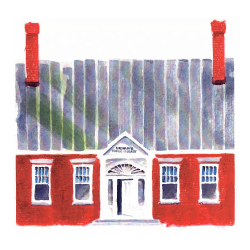Ainsworth Public Library, 1911
Williamstown’s red brick library, located in the village on Route 14, was built as a private home in 1833 by Enoch Howe, a blacksmith and prominent citizen. On the front lawn is a large granite boulder with a bronze plaque honoring Thomas Davenport, inventor of the electric motor, who was born in 1802 and who was an apprentice to Howe.
On January 22, 1801, a year before Davenport’s birth, 34 men and one woman founded the Williamstown Social Library, the third such town library in Vermont ( the other two, also in Orange Country, were Brookfield in 1791 and Bradford in 1796). Books were circulated using a bidding process as at auctions, which were held quarterly. The books, covered in leather, were kept in a chest and carted to each auction place. Pride’s and Martyn’s stores, two private homes and the Town Hall were used.
While mostly men started the first library, the second can be credited to a women’s group, the Williamstown Village Improvement Society, which began the Free Public Library. In 1911, Laura B. Ainsworth offered to help the town establish one library, provided the two existing groups pooled their books for a library under town control. When this was agreed to, Mrs. Ainsworth, who had previously bought the Howe House, donated it along with interest from a $2,000 fund.
The renovation included removing partitions and adding oak bookshelves and furniture. The building has a columned porch and door with three-quarter sidelights and fanlight. The inside, one large room with adequate shelving, has been well-converted to include a children’s room. There are two public access computers as well as wi-fi access for patrons with their own computers. Upstairs include two rooms. The larger front room is available to the public with a large table for meetings, two individual study areas (one with a stand alone computer), individual chairs and cushioned seating, a large collection of biographies, historical books, and an area devoted to Vermont. The second room is used for storage and sorting and other staff needs.
The basement has a dirt floor and exposed beams. The original bark still clings to the wood, offering a little-seen glimpse into how houses were built nearly 200 years ago.

